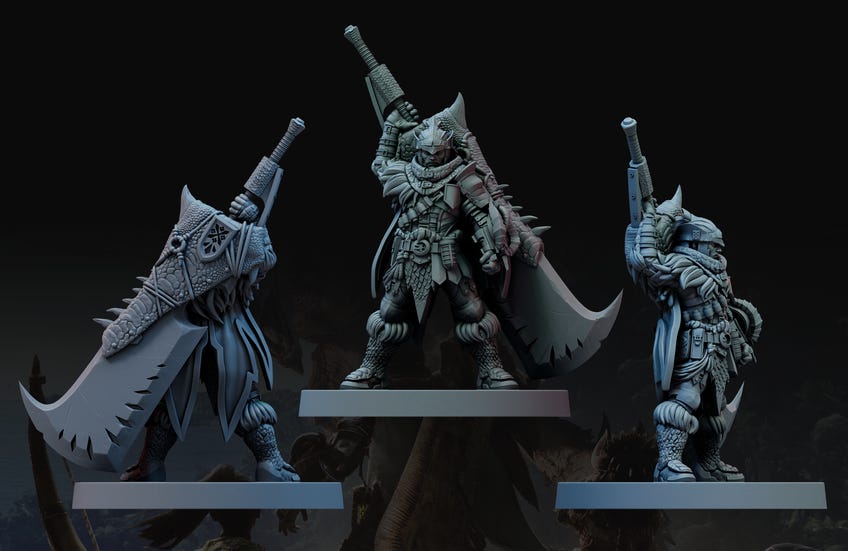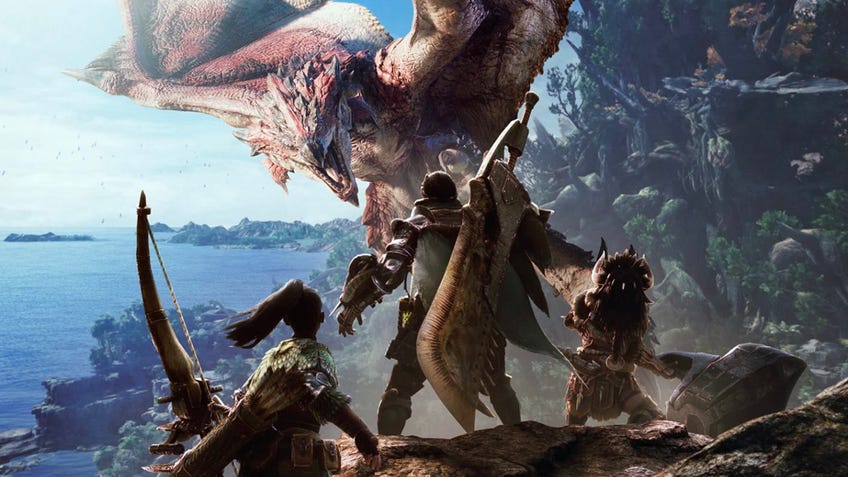Monster Hunter World: The Board Game’s designers on tracking down the perfect tabletop adaptation
“We like people to make difficult choices that are also fun choices.”
“When you play a video game, or you read a book, or you watch a show on Netflix, it triggers an emotional response in you. Now, sometimes it might be frustration, and sometimes it might be fear. Sometimes it might be a compulsive behavior to collect and discover more,” Mat Hart, creative lead at Steamforged Games, tells Dicebreaker.
“But it's really understanding the emotional response that's created by the original IP. And then how can we recreate that same emotional response through the medium that we create?”
He and his design studio are currently adapting the 2017 Capcom video game Monster Hunter World into an upcoming board game, which will launch a Kickstarter in April. A look at Steamforged’s record shows a pedigree for tackling mechanically-heavy games such as Dark Souls and Devil May Cry in an attempt to capture the essence of the source material without any digital artifice.

Hart says Steamforged’s prior relationship with Capcom on the Resident Evil board games made it easy to bring up Monster Hunter World. Steamforged was eager and Capcom had faith in its ability to translate the game’s several overlapping systems. For two years, the team has been chipping away at a block of marble and searching for the perfection within. Hart says the ace tool in their belt was product owner Alex Hall.
When they buy this box, is that going to live up to expectations? Are they going to be happy with it?
That job title isn’t something you see every day, which Hall understands. “Ultimately, my role with any project I'm on is to be trying to make sure that it's the best product it can possibly be,” he says. “I look at it from the customer angle - when they buy this box, is that going to live up to expectations? Are they going to be happy with it?”
Hall began playing with Monster Hunter 4 Ultimate on the Nintendo 3DS. The long-running series has been popular in Japan for a while but never found more than enthusiast support in Europe or the US before Monster Hunter World. Hall can’t say exactly how many hours he’s played, but it likely stretches into four-digit figures. Hart and lead developer Jamie Perkins say his expertise and love for the game are the lifeblood of their success.
The team knows they have a tall order to fulfill if they want to satisfy fans by translating a love and appreciation for a title that sold over 6.6 million copies, while also allowing the board game to be approachable for newcomers and the curious. They decided to start at the centre and let the snowflake form around one key granule.
“Boiling Monster Hunter down to its core, it's like a boss fight game,” Hart says. Steamforged previously tackled a similar challenge with 2017’s Dark Souls: The Board Game, which exploded on Kickstarter and afforded the studio new levels of exposure. While reviews of the game criticised its turn-by-turn play as sloggy and unfun, the boss AI system was a marvel of design. Hall tells me they have only improved on that work since, and it serves as the ground floor of Monster Hunter’s ecological interactions.

As Dicebreaker revealed last week, Monster Hunter World: The Board Game will use a deck of monster behaviour cards to dictate how many player-controlled hunters can respond to each attack. Fights feel like deadly dances where the massive beast controls the flow and tempo, and hunters are left searching for the perfect opening.
You need to be invested in and care about the things that you're killing.
A larger challenge was preserving the tempo of play. All three designers speak about the different systems they’ve integrated into the board game - gathering and crafting, gear, tracking a monster, and simply soaking in the environment - but understand they need to weave them together in such a way that the inertia of the hunt doesn’t bleed out somewhere along that path.
Gathering, carving pieces out of a felled monster and crafting halted the flow of play so one or more players could don their accountant’s hat. Instead, they moved all of that to the post-victory phase of every hunt, a sort of denouement where everyone can breathe, soak in victorious exaltation and count up their loot.

It also revealed to Steamforged the solution to another problem: how would they tie all of the hunts together?
“Out of that challenge came an opportunity to really create a campaign feel to the game,” Hart says. “Do you spend your time hunting another Jagras because you need to find a certain piece in order to finish off the armour set that you've got? Or do you choose to go on to a different quarry? And how does that affect the story that you're building at the table?”
The team spoke early on about whether or not the board game should feel like one-session hunts with different monsters essentially riffing on a standard formula. With their boss mechanics developed first, the team had a fun experience that fizzled and died once the monster was killed. “You need to be invested in and care about the things that you're killing. There needs to be something at the end of it that you want,” Hall says.
They looked to the structure of the video game, which they describe as weirdly backwards to how many video games play: hunters kill monsters for the end goal of gathering loot, rather than amassing resources to eventually tackle the boss at the end. Hunters’ armour and weapons are marks of progress as much as they are keys to unlocking a progression of gates along the game’s narrative.
Perkins’ responsibility came into focus once the campaign structure had been implemented. He and his team finely tuned the interactions so that nothing felt too repetitive, even for a Monster Hunter game. The team understood and embraced the somewhat “grindy” structure by deepening the systems enough that hunters could invest their energy in fully understanding and mastering each monster’s behaviour over multiple hunts.
The team needed to ensure those without prior experience could enjoy themselves, as well. “We did a heck of a lot of predictive mapping, trying to make sure that the average amount of hunts that you would take to face a monster to get the appropriate equipment that you then need to go on to the next monster is not too long,” Perkins says. Crunching that “deep math” allowed them to design a balance that would provide a cushion for the unlucky or inexperienced, while veteran hunters could move on and enjoy the mechanical challenge of not being quite as prepared for the next monster up the difficulty ladder.
Monster Hunter World: The Board Game will launch a Kickstarter campaign in April of this year. More details on what’s included can be found in our previous look at the upcoming title - and while Hart and his team won’t be nailed down on whether future boxes might be based on the video game’s 2019 expansion Iceborne, he doesn’t dash all hopes.
“The standard answer to this is we will be crazy not to be thinking about that. Sure. Which is not an answer, really. But you knew that,” he says. “We really believe this is going to be a massive IP for us. So we're going to carry on supporting it for sure.”
Product images show in-development content subject to licensor approval.


